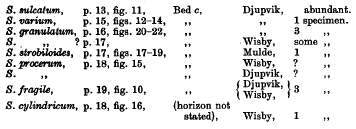Article contents
I.—Studies in Edrioasteroidea. VI. Pyrgocystis n.g.
Published online by Cambridge University Press: 01 May 2009
Extract
Previous History.—In 1892 Professor Carl W. S. Aurivillius published his well-known paper “Ueber einige ober-silurische Cirripeden aus Gotland” (Bihang Svenska Vet.-Akad. Handl. Bd 18, Aid. IV, No. 3). Besides the remarkable specimen from the Ludlovian Pterygotus bed of Wisby, to which he gave the name Pollicipes signatus, and a supposed fragment of a scutum, which he called P. validus, Professor Aurivillius described a number of “kurze, mehr oder weniger cylindrische, mit Schuppen bedeckte Bildungen”, which he regarded as the peduncles of a cirripede and referred provisionally, in the absence of any trace of a capitulum, to Scalpellum. Though all the specimens (except possibly of S. cylindricum) came from a single stratum, bed c of Lindström, probably contemporaneous with our Wenlock Shale, and though the majority were found in a single locality, Djupvik in Eksta, still Professor Aurivillius considered that he could with certainty distinguish the following seven species:
- Type
- Original Articles
- Information
- Copyright
- Copyright © Cambridge University Press 1915
References
page 50 note 1 Scillælepas carinata (Phil.), Miocene, Sicily: Seguenza, 1876, Atti Accad. Pontaniana, vol. x, pl. viii, fig. 14Google Scholar; and Pollicipes concinnus Morris, Oxford Clay, England: Darwin, 1851, Pal. Soc. Monogr. Foss. Lepadidre, p. 50, pl. iii, fig. 1.Google Scholar
page 57 note 1  , a tower.
, a tower.
- 3
- Cited by


